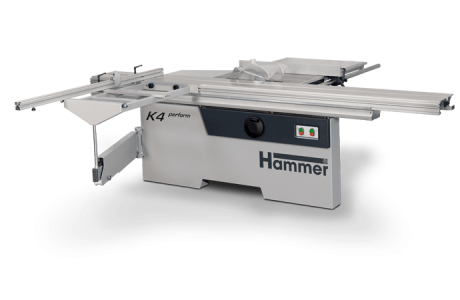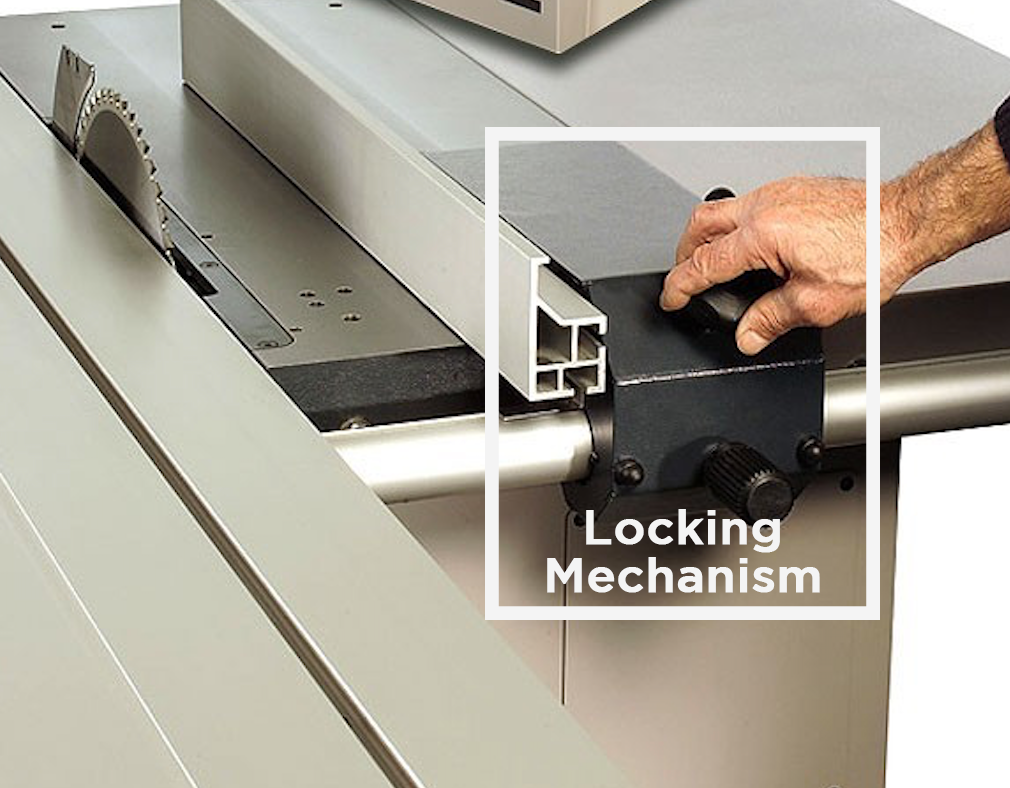An overview of all the Hammer table and panel saws and a look at their differences.

There are so many possible table saws to choose from as a hobbyist woodworker, that it can be hard to make sense of them all. Let’s assume you’ve made the decision to go for a stationary saw. What is it that makes Hammer table saws different? Their main selling points are their high quality standards, and sliding table.
In this article, we’ll take a look at the Hammer saws and try to give you a clear overview of the differences between the models. The four models can be split in three and one: The K3 Basic, Winner, and Winner Comfort, which are all built on the same compact frame, and the K4 Perform, which is actually built on a Felder panel saw body.
We’ll also look critically at the upgrades, and try to figure out whether they’re worth it (and for who), and briefly consider the Hammer B3 and C3 combination machines that are essentially K3 machines with extra features added. With this guide we hope you’ll be able to make a more informed decision when it comes to your next table saw.
Type of machine
Table Saw
Designed in
Austria
Manufacturer
Hammer
Production status
New
There are three machines in the Hammer K3 series: The K3 Basic, which, as the name suggests, is the most barebones version. The K3 Winner, which has a longer sliding table and more upgrades available, and the K3 Winner Comfort, which has a long sliding table and outrigger table in its standard kit. Before comparing them, let us first take a look at their features and options.
All K3 machines in their standard package come with an aluminium rip fence, which gives 700mm rip capacity on the Basic, and 800mm on the other two machines. The rip fence is moved left and right over a round aluminium extrusion and locked into place by turning a knob.
The exception to this is the K3 Basic, which uses a normal aluminium (not round) extrusion to slide over. The upgrades mentioned below are therefore not available for the Basic, with the exception of the fine-adjustment setting.
The fence itself can be moved forward and backwards, so that you can also set it up before the saw blade and use it as a stop for cross-cutting. The fence can also be turned 90 degrees so that its height is less than a centimeter. This helps with cutting thin strips.
There are several upgrades available for this system. The round bar over which the fence moves can be upgraded to a longer (possibly cast iron) one, extending up to 1250mm. In that case you would also need a small extension table, because the bar would extend past the table top.

Another upgrade is the ‘locking’ mechanism (for lack of a better term). This can be upgraded to a cast-iron one, which has a quick-release handle, which the standard version does not have. This makes it much easier to quickly move the fence left and right. This version is the same that come standard on Felder machines.
Both the original and the cast-iron locking mechanism can be upgraded with a fine-adjustment setting knob. This allows you to lock the fence in place, and then turn the knob to move the fence ever so slightly to get it to the perfect position. It does seem strange that this is not a standard feature on such a precision machine.
One of the key features of the Hammer saws is its excellent sliding table. Traditionally sliding tables were mostly seen on panel saws, to help with cutting large sheet goods, but they are useful on table saws too. They make cross-cutting on a table saw much easier, and forego the need to build a crosscut sled. They are also great for cutting the first straight edge on a rough board (there is also an add-on to help you secure your board for this specific purpose).
The sliding table is also an area where the difference between the top of the line Felder machines and the more affordable Hammers is noticeable. Whereas most Felder machines use linear guide rails, which move very quietly, the K3 saws use ball bearings. These are not necessarily loud, but they do make a noise, and some more friction is noticeable. They do still move smoothly, and it is debatable how much you will notice it in daily use.
For the K3 saws, you can choose between three sliding table lengths:
While the sliding table is good on its own, the crosscut fence and outrigger table are what makes it really shine. With the indexing system of the crosscut fence you can easily make crosscuts of various angles, eliminating the need to build crosscut sleds and tapering jigs.
The cross-cut fence can be locked in place, and then the 90 degrees position can be marked with a clever flip-stop system, allowing you to always return quickly to the 90 degrees position without error. This flip-stop system was initially flawed, but after youtuber Marius Hornberger made a video about this, Felder released an improved model, which you can see here.
The K3 Basic and Winner both come with a standard 900 mm crosscut fence, while the Winner Comfort has a longer (1300 mm) fence which is specifically for the outrigger table. If you plan on using the Winner Comfort without the outrigger table, you may need to purchase the standard crosscut fence separately. Similarly, you would need to upgrade to the longer fence if you get the outrigger table on the Winner.
The standard 900 mm fence can also be extended by a 750 mm add-on. This does not add any extra support however, so if you plan on crosscutting large boards you may want to consider the outrigger table in any case. Alternatively you can also mount a small extension table to the sliding table.
The outrigger table is primarily useful for cutting larger sheets, effectively turning the K3 table saw into a small panel saw. It does take up a lot of space on the side though, but if you don’t need to use it for a while, you can simply remove the top, and fold the support piece against the side of the machine. It even has a magnet on it so it stays in place.
The outrigger table is another example of Hammer being slightly cheaper built than the Felder machines. Whereas the Felder outrigger tables are made from 5 mm steel, the Hammer ones are made from 3mm steel. The Hammer machines are expected to receive less abuse, because they are not made for daily 9 to 5 use, so it should be strong enough.
What would a machine be without optional extras? Picking the specific accessories you want is one of the fun parts of buying a new machine.
The K3 series can be outfitted with a scoring blade, which will help prevent tear-out, especially on fine veneer sheet material. The cut quality of the Hammer is already quite good, so this upgrade is mostly worth it for people who do much work with high quality veneers.
One advantage of the Hammer machines is the possibility to add dado blades, which is not always available on European machines due to EU regulations. You will need to purchase this upgrade when you order the machine though, because it means a change to the arbor system which cannot easily be fitter afterwards.
There are also several extension tables available, which are not listed on the normal Felder and Hammer pages, but can be found in their webshop. There are sheet metal extensions for the sides, and aluminium profile ones for the front and back, with the possibility of adding a supporting leg.
Now then, knowing all the different types of upgrades to the fences, outrigger table, sliding table and more, which machine is the best? The answer is: It depends. It depends primarily on your specific situation. All versions of the K3 series are solid machines, as long as you don’t intend to use them for all day long professional use. Which specs and upgrades are right for you depend on the type of materials you mainly use, on how much space you have, and on your budget.
If you plan to mostly use sheet goods, the outrigger table is a huge improvement, but you need to have the space for it. Also take into account that a sliding table means you need to have extra space in front and behind the machine for it to move. The long sliding table plus the outrigger table is also one of the more expensive upgrades, so you need to have the budget for it as well. To put it into perspective: The K3 Winner Comfort is almost twice the price of the K3 Winner.
The difference between the K3 Basic and K3 Winner is much smaller however, with the latter being only 10% more expensive. The main benefit of this upgrade is the round bar for the fence, which allows you to upgrade the rip fence to a cast iron one. Even if you don’t want to do that straight away, it’s nice to know that option is available for you later.
Review Tips: If you want to see some in-depth reviews and personal experiences with these machines, I would recommend watching this video by Preston Hoffman, who owns the K3 Winner and this video by Marius Hornberger about the K3 Basic.
Type of machine
Panel Saw
Designed in
Austria
Manufacturer
Hammer
Production status
New
Are the K3 saws not large enough for you? But do you not want to move up to the professional price range? Then the Hammer K4 Perform may be the machine for you. It is a panel saw with Hammer internals on a Felder base.
The K4 Perform’s frame is much longer and a bit wider than the K3 ones. This allows it to support a 3200 mm sliding table, which is more than 1000 mm longer than the one on the K3 Winner Comfort. The outrigger table and accompanying crosscut fence are also larger. These upgrades are very useful when cutting large sheets.
Some other small improvements are the fact that the on-off switch is in a slightly more convenient position, and there are more options available for the overhead blade guard and dust collection.
The K4 Perform is about 40% more expensive than the K3 Winner Comfort. It is a machine truly made for small to medium-sized businesses, while the K3 series are also great for hobbyists. It will depend on your specific business case whether the extra investment will be worth it.
One thing to consider though, is that the K4 Perform has several upgrades, such as the scoring unit and the more powerful motor, in its standard package. If you were going to purchase these options anyway on the K3 Winner Comfort, the price difference between the two becomes less.
If you are looking at purchasing a saw from the Hammer K3 and K4 series, you are likely a serious enthusiast. This means you will probably have more woodworking machines than just a saw. If that’s the case, consider looking at two other Hammer series:
These machines are very similar to the K3 series, as they use practically the same base, but with some extra functionality added. The B3 adds a spindle moulder under the table top, while the C3 machines also add a jointer-planer (with the option of a mortising table) to the side.
We will get to these machines in more detail in a later article, but you can find out a short description to see the differences between them in our database.
© Machine Atlas 2025
How much in Rand
Try contacting the Felder group in South Africa, they can give you the exact pricing: http://www.felder.co.za/products/program/region/za-en
How much is asliding table saw